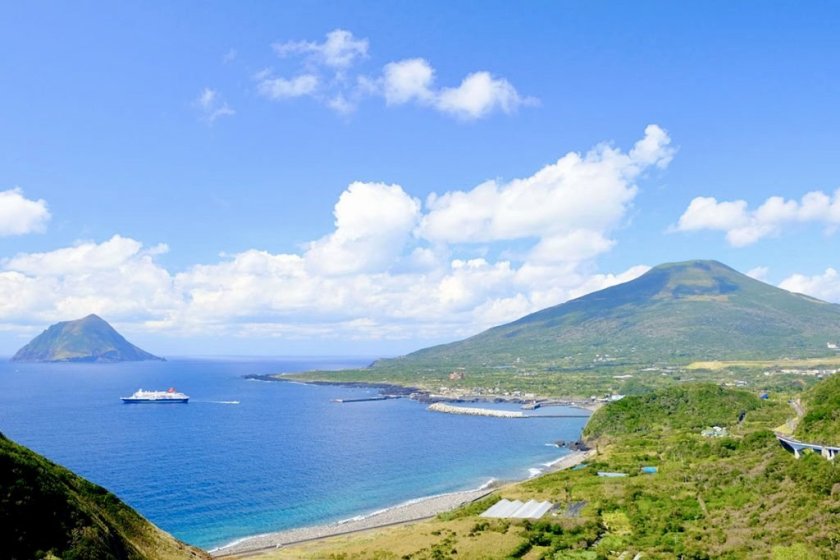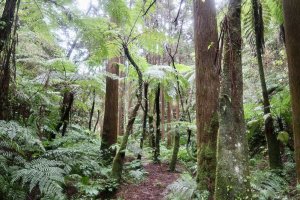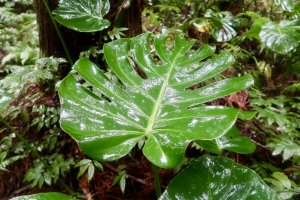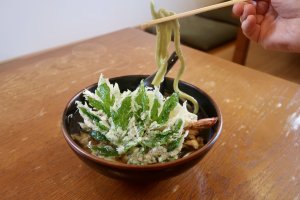Explore an exotic side of Tokyo on Hachijojima! This island paradise, situated about 286 km south of Tokyo, is only about an hour's flight from the city streets and boasts an alluring environment perfect for mental and physical rejuvenation.
A part of Tokyo Prefecture’s Izu Islands, Hachijojima is a picturesque getaway characterized by its volcanic terrain, mountainous sceneries, and distinct flora and fauna. In this blessed environment, visitors can take a break from their everyday lives and embark on adventures filled with hiking, whale watching, hot springs, and so much more! In terms of cuisine, the island is renowned for its exceedingly fresh seafood, as well as its luscious dairy products made with milk produced by resident Jersey cows.
So, if you are looking for an unforgettable journey in an unexplored side of Tokyo, check out our two-day itinerary below and follow my personal exploration of Hachijojima!
Itinerary outline
Day 1 → Hego Forest hiking tour → Lunch at Nadai Ikkyuan → Dessert at Jersey Cafe → Sunset views at Nambara Senjojiki → Dinner at Hachijojima Local Cuisine Ryozanpaku
Day 2 → Whale watching → Relaxation at Miharashi-no-Yu Hot Spring → Hachijo Botanical Park → Hachijo Visitor Center
Day 1
Hego Forest hiking tour

After a mere one-hour flight from Haneda Airport, we began our adventure with a private Hego Forest Tour and refreshed our senses in the exotic environment. Called Hegonomori in Japanese, Hego Forest is an atmospheric location renowned for its abundance of ferns, namely hego, which are a type of tree fern. While ferns typically grow low to the ground, hego have tall rootstalks (not to be confused with trunks) and rise well above hikers—creating a canopy of prehistoric-esque foliage. Hego Forest is home to approximately 1,000 hego, and Hachijojima itself is the northernmost part of Japan where you can observe these plants.

Upon entering the forest, I was instantly whisked away to the Jurassic Period. The culmination of ferns at my feet and above my head created a secluded landscape that I have only encountered in fiction. Although it was drizzling during our hike, the weather added a misty allure to the verdant landscape, which was further enhanced by a symphony of chirping birds, rustling leaves, soft raindrops, and running water.

During the excursion, our friendly and knowledgeable guide stopped periodically to introduce different types of ferns and encouraged us to feel the plants’ varied textures. We even met some adorable Japanese red-bellied newts with vibrant red undersides and witnessed the forest’s oldest fern tree, which is said to be 400 years old. Thanks to the numerous educational rests, the hike was a leisure and engaging experience.

Since Hego Forest is private property, you must reserve a certified guide to explore the area. Please email 8jo.hegonomori@gmail.com to reserve a guide and add all the necessary information as noted on this website. If you need an English-speaking guide, please request so in your email. The tour is about 1.5 to two hours and will operate even in light rain. So, be sure to wear appropriate hiking shoes and attire according to the weather.
Details
- Address of meeting spot: 3376 Nakanogo, Hachijo, Tokyo 100-1623 (Google Map)
- Website: https://8jo.org/tour-of-forest-of-tree-ferns/ (Japanese only)
Lunch at Nadai Ikkyuan

After stretching our legs amidst dinosaur-reminiscent trees, we returned to the present and stopped by Nadai Ikkyuan for lunch, a restaurant that serves a variety of soba (buckwheat noodles) and udon dishes crafted with local ingredients. One of the eatery’s key selling points is its homemade ashitaba udon and soba noodles. Ashitaba, which translates to “tomorrow’s leaf,” is a species of flowering plant that is native to the Izu Islands and has a slightly bitter and refreshing taste.
Ashitaba powder was introduced about 30 years ago, and Nadai Ikkyuan’s original owner wondered what it would be like to add the powder to noodles. The answer was chewy, green-tinted noodles with subtle ashitaba undertones. Today, the original shop owner’s son continues his father’s legacy with delectable handcrafted noodles.

The restaurant’s two most popular dishes are its katsu (fried pork cutlet) curry udon and tempura udon. I opted for the latter and it met and exceeded all my expectations! The hearty bowl of thick noodles and light broth was topped with a massive piece of shrimp tempura and crispy ashitaba tempura. I highly recommend you eat the tempura quickly so it retains its satisfying crunch. Each noodle had a slightly different shape, highlighting its authenticity and handmade charm. The meal was warming, nourishing, and satisfying.
Inside, the restaurant has table, counter, and floor seating. Since this spot is a local favorite, please be aware that it can be crowded around lunchtime. Although the eatery only has a Japanese menu, you can easily decipher it with translation tools, such as Google Translate.
Details
- Address: 2472-2 Okago, Hachijo, Tokyo 100-1401 (Google Map)
- Business hours: 11:30am–2:30pm
- Closed: Thursday
- Website: https://www.hachijo.gr.jp/restaurant/ikkyuan/ (Machine-translated English available, select 英語)
Dessert at Jersey Cafe

While on Hachijojima, dairy products are a must! Since Hachijojima’s Jersey cows are raised in open fields and eat nourishing island grass, they yield high-quality milk, which Hachijojima then uses to produce delicious ice cream, gelato, cheese, pudding, and more.
For tasty dairy treats, Jersey Cafe is the place to go. This small space with big coffeehouse vibes serves soft serve ice cream, sundaes, floats, cafe au lait, cookies, cheesecake, pudding, and yogurt drinks, as well as cafe staples, like coffee, tea, and juice. Of course, the soft serve is one of the cafe’s biggest sellers, and you can even order ashitaba-flavored ice cream! Another best-seller is the cafe’s Jersey milk pudding, which it serves in small glass bottles reminiscent of classic milk bottles.

Since the ashitaba tempura paired with my lunch truly captured my tastebuds, I decided to treat myself to the cafe’s ashitaba soft serve, which, visually, is characterized by its soft green hue. The ice cream’s texture was simultaneously thick and velvety, and it had a rich, not-too-sweet dairy flavor that perfectly melded with the ashitaba’s earthiness. The dessert was an exceptional bite, and as I enjoyed my treat, numerous visitors came and went, showcasing the cafe’s popularity.
Details
- Address: 2370-1 Okago, Hachijo, Tokyo (Google Map)
- Business hours: 10am–5pm
- Closed: open every day
- Website: https://www.hachijo.gr.jp/restaurant/jerseycafe/ (Machine-translated English available, select 英語)
Sunset views at Nambara Senjojiki

Given Hachijojima’s paradise-esque landscapes, it is no surprise that the island is home to some heavenly sunsets, and Nambara Senjojiki is a prime spot! Situated on Hachijojima’s western coast, Nambara Senjojiki is a 500-meter long,100-meter wide black lava plateau formed by Mt. Hachijo-Fuji’s past eruptions. From the darkened, rugged shoreline, you can admire views of the ever-shifting sea with the majestic form of Hachijo-kojima, an uninhabited island, in the distance. The area has public restrooms and a parking lot.
Luckily for us, Hachijojima’s skies cleared up just in time for the sun’s descent. We watched mesmerized as varied hues of yellow and orange bled into the darkening sky. The colors’ vibrancy highlighted Hachijo-kojima’s tapered silhouette, giving it the appearance of a mountain sitting atop the waves. The ethereal scenery, paired with the tide’s soothing melody and refreshing breeze, catered to all my senses and firmly planted me in the present where I was content to simply bear witness to nature’s splendor.
Details
- Address: 8257 Okago, Hachijo, Tokyo 100-1401 (Google Map)
- Website: https://www.gotokyo.org/en/spot/473/index.html
Dinner at Hachijojima Local Cuisine Ryozanpaku

Hachijojima Local Cuisine Ryozanpaku (hereinafter Ryozanpaku) is a must-visit restaurant on Hachijojima. This over 30-year old izakaya, or traditional Japanese-style bar, serves an array of island food specialties, as well as unique drinks like Hachijojima shochu (Japanese distilled liquor) and ashitaba beer! Ryozanpaku’s island sushi, called shimazushi in Japanese, is one of its most popular offerings and fluctuates frequently with the catches of the day. Given the limited quantities, reservations are required for island sushi, and the restaurant has an English-speaking staff member to help with phone calls when available. The restaurant also has English translations on its menus.
The modern yet traditional interior creates a cozy space where tourists and locals alike can unwind after a long day. The restaurant has counter seats, semi-traditional banquet seats, and private rooms.

During my visit, we secured a private room to enjoy our island feast. For appetizers, we ordered Hachijojima mozzarella and tomato slices garnished with pesto, ashitaba tempura (served with salt from Aogashima), Hachijo pickles, and roasted shiitake. The array of flavors and textures both satisfied and heightened my appetite. Again, the ashitaba tempura, which was airy and crispy, was one of my favorite dishes. For a beverage, I ordered the ashitaba tea, which had a refreshing flavor with a subtle herbal aroma.

Then, came the star of the night—island sushi! I am not exaggerating when I say that this sushi is some of the best sushi I have ever had. Island sushi differs from typical sushi in that the fish is marinated in soy sauce and paired with karashi, spicy Japanese mustard, instead of wasabi. The sushi of the day featured striped marlin, moontail bullseye, Japanese butterfish, and rock seaweed. The savoriness of the soy sauce and slight bite of the mustard paired expertly with the melt-in-your-mouth fish and vinegared rice. The flavors elicited wide smiles from all the guests at the dinner table.

We followed the island sushi with sashimi, which was also incredibly fresh and addicting, and ended our meal with sweet Hachijo milk ice cream.
The meal thoroughly satisfied my stomach and soul. For sushi lovers, Ryozanpaku is non negotiable.
Details
- Address: 1672 Mitsune, Hachijo, Tokyo 100-1511 (Google Map)
- Business hours: 5:30pm–10pm
- Closed: Sunday
- Website: https://www.hachijo.gr.jp/restaurant/ryozanpaku/ (Machine-translated English available, select 英語)
Day 2
Whale watching

We were hoping to start our morning with whale watching, but unfortunately, the tour was canceled due to inclement weather. Even so, whale watching is one of Hachijojima’s most prized offerings and deserves recognition.
Since 2015, the number of humpback whales visiting the waters around Hachijojima during winter has been steadily increasing. As humpback whales tend to be more agile and active than other whale species, they make for exciting creatures to observe.

While it is possible to see these majestic animals from the shore, we highly recommend a whale watching cruise to see them up close in their natural habitat. Ocean Boulevard is a company that offers three-hour tours on Fridays, Saturdays, and Sundays during winter, and the experience itself is led by a veteran fisherman who is an expert of Hachijojima’s waters. The encounter rate from 2022 to 2023, including indirect sightings, such as water spray from blowholes, was 95%!
I can imagine that the quiet anticipation and constant vigilance makes the activity an extremely mindful experience.
Given that whale watching in Hachijojima is a wintertime activity, please dress appropriately against the wind and low temperatures. Advanced reservations are required, and you must arrive on Hachijojima the day before the whale watching tour to be eligible for the activity.
Details
- Address: nearest bus stop to port
- Duration: 9am–1pm
- Unavailable: Monday-Thursday; spring-autumn
- Website: https://www.hachijo-diving.com/diving/index.html?cnt_selectcatno=002&name=%83z%83G%81[%83%8B%83E%83H%83b%83%60%83%93%83O (Japanese only)
Relaxation at Miharashi-no-Yu Hot Spring

Instead of whale watching, we started our day with a healing soak at Miharashi-no-Yu Hot Spring. This hot spring facility is Hachijojima’s most popular onsen and offers indoor and outdoor baths beside the sea. The outdoor baths are especially favored as they boast unobstructed views of Hachijojima’s coast and the grand ocean beyond. Miharashi-no-Yu’s hot springs, which are typically around 47.5℃ (117.5℉), are said to help with chronic pain, stiff muscles, stress, fatigue, and number of other physical and mental ailments.
The baths available for men and women swap every other day, and the facility sells Hachijojima towels for bathing if you do not have your own. If you are unfamiliar with onsen etiquette, please review the appropriate manners beforehand for an authentic and respectful experience.

I, of course, was most excited for the outdoor bath, and as I submerged myself in its revitalizing waters, I felt my mind instantly calm. The unspoilt scenery coupled with the sea’s melodic fluctuations served as a peaceful lullaby. Once I felt warmed to my core, I purchased a chilled beverage from the onsite vending machine and moved to the facility’s rest area. Here, I lounged on tatami floors and continued my admiration of the scenery from the room’s floor-to-ceiling windows. The enchanting vistas and nourishing hot spring water left me feeling refreshed inside and out.
Details
- Address: 581-1 Sueyoshi, Hachijo, Tokyo 100-1622 (Google Map)
- Business hours: 10:30am–9:30pm (last admission is 9pm)
- Closed: Tuesday
- Website: https://www.gotokyo.org/en/spot/757/index.html
Hachijo Botanical Garden

After witnessing Hachijojima’s stunning landscapes from afar, we continued our exploration of its environment up close at Hachijo Botanical Garden. This 22.4-hectare (55.4-acre) park, opened in 1962, is home to an array of intriguing flora and fauna, including wild birds and adorable miniature deer called kyon in Japanese.

Many of the walkways throughout the facility are lined with red volcanic gravel (called scoria), adding to the area’s exotic ambience. One of the park’s most notable characteristics is its greenhouse, which houses over 100 species of plants. If you visit in summer, keep your eye out for vibrant hibiscus and bougainvillea flowers! The garden is scattered with water fountains, bathrooms, and benches, ensuring a comfortable visit.

From the park’s entrance, we were immediately welcomed by rows of waving palm trees and an epic view of Mt. Hachijo-Fuji rising in the distance. Before we started our exploration, we first stopped by Hachijo Visitor Center, also located in the park, to grab an English pamphlet with a map of the area’s offerings. Then, for about an hour and a half, we leisurely wandered through the park’s eight zones and observed conspicuous plants, hardwood and softwood trees, and palm trees. In addition to Hachijojima-native plants, we also viewed trees from other countries, as well as Japan-native ones. One of my favorite sights was the Magnolia kobus, located in the Trees of Japan area, since it was blooming with attractive white flowers. In the large greenhouse, I was especially mesmerized by the vibrant colors of some of the flowers and plants.
Details
- Address: 2843 Okago, Hachijo, Tokyo 100-1401 (Google Map)
- Business hours: open 24 hours (greenhouse open from 9am–4:30pm)
- Closed: open every day
- Website: https://www.gotokyo.org/en/spot/339/index.html
Hachijo Visitor Center

We ended our island trip at Hachijo Visitor Center. This facility displays information about Hachijojima’s natural environment and history, making it a great place to learn about the wonders you have experienced thus far. The center is close to Hachijojima Airport, so logistically, it is a convenient place to wrap up your adventure. Alternatively, thanks to its location and specialized information, the facility also serves as an ideal way to start your trip.

Here, you can learn about the island’s plantlife, animals, climate, and more. The facility also has a lecture room where it shows a short video with English subtitles about Hachijojima’s ecosystems and culture. I highly recommend watching the video as it offers a lot of interesting information. Other highlights include a small aquarium with colorful fish, a circular rest area with photos of Hachijojima’s stunning panoramas, and a small shop where you can purchase goods and ice cream. The stand has unique flavors such as salted milk, ashitaba, and even shiitake! Although the exhibits are in Japanese, you can use translation tools on your phone to read them.

Without a doubt, I was most excited to see Hachijojima’s famous luminescent fungi that glow in the dark! Typically, you can only see these mushrooms during summer, but the Hachijo Visitor Center displays them year-round. These alien-esque mushrooms emit a bright green glow, giving them an otherworldly appearance. They were truly a hypnotizing feat of nature. Please note that the facility does not showcase the mushrooms every day.
While relatively small, the center created an inquisitive atmosphere that prompted me to consider Hachijojima’s nature on a deeper level.
Details
- Address: 2843 Okago, Hachijo, Tokyo 100-1401 (Google Map)
- Business hours: 9am–4:45pm
- Closed: open every day
- Website: https://www.hachijo.gr.jp/facility/botanical-park/ (Machine-translated English available, select 英語)
Hachijojima awaits!
With its striking natural sceneries, feel-good physical activities, local cuisine, and exotic atmosphere, Hachijojima is both a stimulating and relaxing destination where you can recharge yourself with new experiences. In the island’s fern-filled forests, sunset-painted skies, peaceful ocean vistas, and enriching hot springs, I found fresh perspectives on the world’s beauty outside my daily life. And as I boarded the plane for Haneda Airport, I held these small moments close to my heart, knowing that when the busyness of modern life returns, I can always revisit these immortalized memories of wonder.
Access to Hachijojima

Hachijojima is accessible via ferry and plane.
From Tokyo’s Takeshiba Pier, Tokai Kisen operates one ferry to Hachijojima daily. The ferry ride is about 10 hours and 20 minutes. Alternatively, from Haneda Airport to Hachijojima Airport, All Nippon Airways (ANA) operates three flights daily. The flight time is just under one hour at 55 minutes.
Ferry
- Tokai Kisen Co., Ltd. ferry information: https://www.tokaikisen.co.jp/en/
- Reservation URL: https://tokyoislands.jp
Plane
- ANA reservation URL: https://www.ana.co.jp/en/jp/ *
- *Make sure you are looking at domestic flights. Hachijojima is under the “Kanto/Koshinetsu” section.
Promoted and funded by:
































